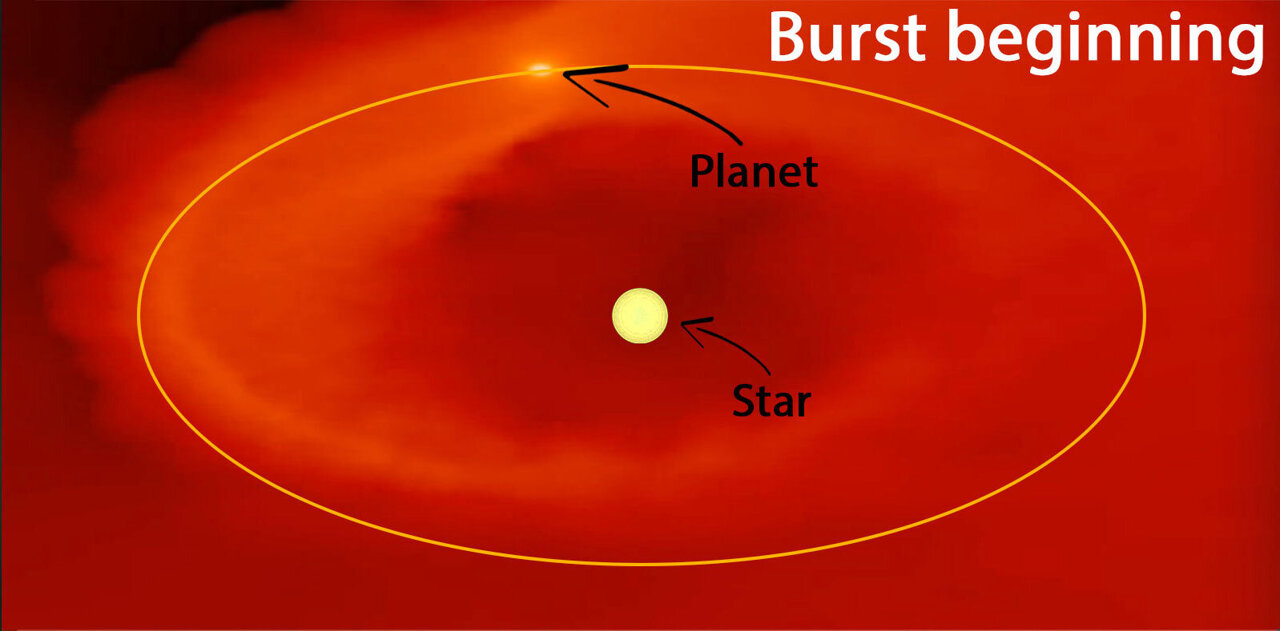FU Orionis is an unusual variable star. It was first seen as a magnitude 16 star in the early 1900s, but in the mid-1930s it rapidly brightened to a magnitude 9 star. The rapid brightening of a star was not unheard of, but in this case, FU Orionis did not fade to its original brightness. Since 1937 it has remained around magnitude 9, varying only slightly over time. For decades the mysterious star was thought to be unique, but in the 1970s similar stars were observed, and are now known as FU Orionis objects. Astronomers still had no real idea what could cause such a dramatic change, but a new study argues that it could be caused by a dying young planet.
FU Orionis is a protostar system, meaning that it is still in the process of fully forming. Observations from the Atacama Large Millimeter/submillimeter Array (ALMA) show that it has two components surrounded by a protoplanetary disk, so it could eventually become a double-star system with planets that orbit both stars. One of the components has a mass about that of the Sun, while the other is small.
Young protostars of this size are known to experience violent flares, but the observed brightness shift was a trillion times more powerful than the strongest solar flares. Stellar flares also don’t last decades, so there must be some other cause for the dramatic brightness shift. The dominant theory is that FU Orionis is accreting material from the disk. The disk material would significantly heat as it’s absorbed, causing the system to brighten. But what would cause the sudden shift in accretion? That’s where this study comes in.

The team simulated an accretion disk similar to FU Orionis but containing a Jupiter-like protoplanet. The simulation showed that due to drag and magnetic forces within the disk, the planetary seed both grew in mass and rapidly shifted its orbit inward. Because of rapid accretion, the protoplanet was more massive than Jupiter, but not nearly as dense. So as it drifted ever closer to the young stars, the atmosphere of the protoplanet became superheated and ignited. This flooded the disk with new material, and much of that material was accreted by the young stars.
Based on the simulation, this violent heating of a young Jovian planet could trigger the kind of rapid and sustained brightness increase we observe in FU Orionis. If the model is correct, it shows how planets can not only form around young stars, they can also be quickly and violently destroyed. It could mean that many, if not most, large planets die before a planetary system settles into a stable state.
A few dozen other protostar systems have had similar shifts in brightness, though none as significant as FU Orionis. In the future, the team would like to create more sophisticated simulations and compare these to other young systems to better understand the complex and chaotic origins of stars and planets.
Reference: Nayakshin, Sergei, James E. Owen, and Vardan Elbakyan. “Extreme evaporation of planets in hot thermally unstable protoplanetary discs: the case of FU Ori.” Monthly Notices of the Royal Astronomical Society 523.1 (2023): 385-403.

